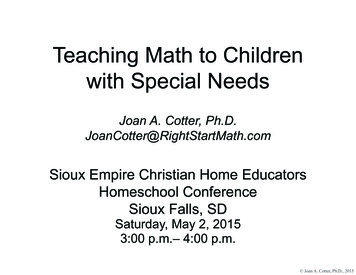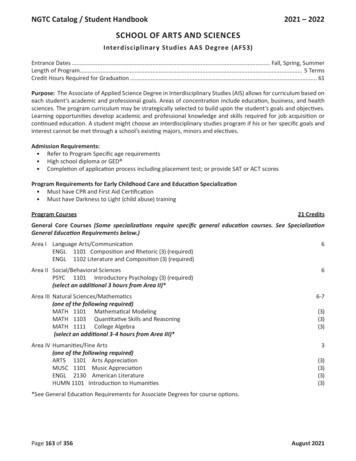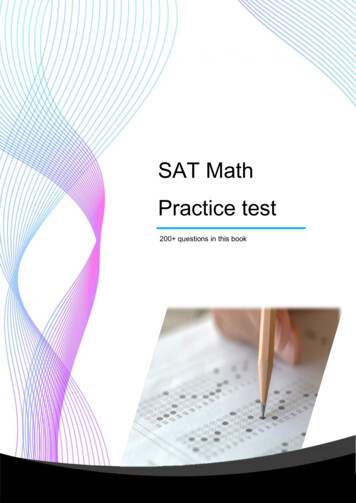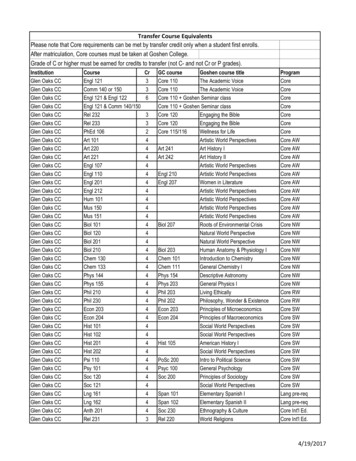
Transcription
Teaching Math to Childrenwith Special NeedsJoan A. Cotter, Ph.D.JoanCotter@RightStartMath.comSioux Empire Christian Home EducatorsHomeschool ConferenceSioux Falls, SDSaturday, May 2, 20153:00 p.m.– 4:00 p.m. Joan A. Cotter, Ph.D., 2015
Myths about LD People with LD have lower intelligence.(33% are gifted.) They are lazy or stubborn. Children with LD can be cured or will outgrow it. Boys are more likely to be affected.(Girls are equally affected.) Dyslexia and learning disability are the same thing. Students with LD and ADHD cannot succeed in higher education. Joan A. Cotter, Ph.D., 2015
Characteristics of LDChild usually: Is more creative. Cannot learn by rote. Must understand and make sense of a concept inorder to remember it. Is more visual and hands-on. Dislikes worksheets. Finds it very difficult to unlearn. Joan A. Cotter, Ph.D., 2015
Problems Occurring with MathDyscalculia Reversals in writing numbers Poor number sense Slow fact retrieval Errors in computation Difficulty in solving word problemsDyscalculia mainly affects arithmetic, not otherbranches of math. Joan A. Cotter, Ph.D., 2015
How Math is Traditionally Taught Counting Learn sequence (number names by heart) One-to-one correspondence (one count per object) Cardinality principle (last number tells how many) Memorizing facts Flash cards and timed tests Rhymes and songs Memorizing algorithms (procedures) Using key words to solve story problems Joan A. Cotter, Ph.D., 2015
Traditional CountingFrom a child’s perspectiveBecause we’re so familiar with 1, 2, 3,we’ll use letters of the alphabet.A 1B 2C 3D 4E 5, and so forth Joan A. Cotter, Ph.D., 2015
Traditional CountingFrom a child’s perspectiveF E ABCDEFABCDEWhat is the sum? Joan A. Cotter, Ph.D., 2015
Traditional CountingFrom a child’s perspectiveF E KABCDEFGHIJK Joan A. Cotter, Ph.D., 2015
Traditional CountingFrom a child’s perspectiveNow memorize the facts!!EH G DD CH FF F Joan A. Cotter, Ph.D., 2015
Traditional CountingFrom a child’s perspectiveH–C Try subtracting by “taking away.” Joan A. Cotter, Ph.D., 2015
Traditional CountingFrom a child’s perspectiveTry skip counting by B’s to T:B, D, . . . , T.What is D E? Joan A. Cotter, Ph.D., 2015
Compared to ReadingJust as reciting the alphabet doesn’t teachreading, counting doesn’t teach arithmetic. Joan A. Cotter, Ph.D., 2015
Counting-Based Arithmetic Rote counting to 100 in kindergarten. Calendars misused to teach counting. Counting on for addition. (Jack and Jill) Counting back for subtraction. Number lines are abstract counting. Skip counting for multiplication facts. Does not work well for money or fractions orreading graphs. Joan A. Cotter, Ph.D., 2015
Memorizing MathPercentage RecallImmediately After 1 day After 4 weeksRote32238Concept696958Math needs to be taught so 95% isunderstood and only 5% memorized.–Richard Skemp Joan A. Cotter, Ph.D., 2015
Memorizing MathAccording to a study with college students,it took them: 93 minutes to learn 200 nonsense syllables. 24 minutes to learn 200 words of text. 10 minutes to learn 200 words of poetry. Joan A. Cotter, Ph.D., 2015
Flash Cards and Timed Tests Often used to teach rote. Liked only by those who don’t need them. Give the false impression that math does notrequire thinking. Often produce stress – children under stress stoplearning. Not concrete – use abstract symbols. Cause stress (may become physically ill). Result in short-term learning. May lead to math anxiety. Joan A. Cotter, Ph.D., 2015
dehsiPubl4102May,VisualizingA pilot study of the effects of RightStartinstruction on early numeracy skills ofchildren with specific language impairmentRiikka Mononen, Pirjo Aunio, Tuire KoponenAbstract:.The children with SLI [specific languageimpairment] began kindergarten with significantlyweaker early numeracy skills compared to their peers.Immediately after the instruction phase, there was nosignificant difference between the groups in countingskills. Joan A. Cotter, Ph.D., 2015
Visualizing Visual is related to seeing. Visualize is to form a mental image. Joan A. Cotter, Ph.D., 2015
VisualizingVisualizing is also needed in other fields: Reading Architecture Sports Astronomy Arts Archeology Geography Chemistry Engineering Physics Construction Surgery Biology History Joan A. Cotter, Ph.D., 2015
VisualizingTry to visualize 8 identical apples without grouping. Joan A. Cotter, Ph.D., 2015
VisualizingNow try to visualize 8 apples: 5 red and 3 green. Joan A. Cotter, Ph.D., 2015
Grouping in FivesEarly Roman numerals123458IIIIIIIIIIVVIII Joan A. Cotter, Ph.D., 2015
Grouping in FivesMusical staff Joan A. Cotter, Ph.D., 2015
Grouping in FivesClocks and nickels Joan A. Cotter, Ph.D., 2015
Grouping in FivesTally marks Joan A. Cotter, Ph.D., 2015
Grouping in FivesSubitizing Instant recognition of quantity is calledsubitizing. Grouping in fives extends subitizing beyondfive. Joan A. Cotter, Ph.D., 2015
Subitizing Five-month-old infants can subitize to 1–3. Three-year-olds can subitize to 1–5. Four-year-olds can subitize 1–10 by groupingwith five. Joan A. Cotter, Ph.D., 2015
Research on SubitizingKaren Wynn’s research Joan A. Cotter, Ph.D., 2015
Research on SubitizingKaren Wynn’s research Joan A. Cotter, Ph.D., 2015
Research on SubitizingKaren Wynn’s research Joan A. Cotter, Ph.D., 2015
Research on SubitizingKaren Wynn’s research Joan A. Cotter, Ph.D., 2015
Research on SubitizingKaren Wynn’s researchYou could say subitizing is much more“natural” than counting. Joan A. Cotter, Ph.D., 2015
Research on SubitizingIn Japanese schools Children are discouraged from usingcounting for adding. They consistently group in fives. Joan A. Cotter, Ph.D., 2015
Quantities 1–10Using fingers Joan A. Cotter, Ph.D., 2015
Quantities 1–10Subitizing five Joan A. Cotter, Ph.D., 2015
Quantities 1–10Subitizing five5 has a middle; 4 does not. Joan A. Cotter, Ph.D., 2015
Quantities 1–10Tally sticksFive as a group. Joan A. Cotter, Ph.D., 2015
Quantities 1–10Tally sticks Joan A. Cotter, Ph.D., 2015
Quantities 1–10Number chart for remembering numerals12345!6!7!8!9!10! Joan A. Cotter, Ph.D., 2015
Quantities 1–10Entering quantities3 Joan A. Cotter, Ph.D., 2015
Quantities 1–10Entering quantities7 Joan A. Cotter, Ph.D., 2015
Quantities 1–10Stairs Joan A. Cotter, Ph.D., 2015
Quantities 1–10Adding Joan A. Cotter, Ph.D., 2015
Quantities 1–10Adding4 3 Joan A. Cotter, Ph.D., 2015
Quantities 1–10Adding4 3 7Japanese children learn to do this mentally. Joan A. Cotter, Ph.D., 2015
GamesGamesMathBooks Reading Games provide interesting repetition neededfor automatic responses in a social setting. Games provide an application for newinformation. Games provide instant feedback. Joan A. Cotter, Ph.D., 2015
GamesGo to the DumpObjective: To learn the facts that total 10:1 92 83 74 65 5It is played similar to Go Fish. Joan A. Cotter, Ph.D., 2015
Place ValueThe problem English-speaking children often think of 14as 14 ones, not 10 and 4 ones. The pattern that is needed to make sense oftens and ones is hidden! Joan A. Cotter, Ph.D., 2015
Place ValueIts importance Place value is the foundation of modernarithmetic. It is critical for understanding algorithms. It must be taught, not left for discovery. Children need the big picture, not tinysnapshots. Joan A. Cotter, Ph.D., 2015
Transparent Number Naming11 ten 112 ten 213 ten 314 ten 4. . . .19 ten 920 2-ten21 2-ten 122 2-ten 223 2-ten 3. . . . . . .99 9-ten 9 Joan A. Cotter, Ph.D., 2015
Transparent Number Naming137 1 hundred 3-ten 7or137 1 hundred and 3-ten 7 Joan A. Cotter, Ph.D., 2015
Average Highest Number CountedTransparent Number Naming1009080ChineseU.S.transparentKorean formal[math way]non-transparentKorean informal[not explicit]70605040302010045Ages (years)6Song, M., & Ginsburg, H. (1988). p. 326. The effect of the Korean number system on young children's counting:A natural experiment in numerical bilingualism. International Journal of Psychology, 23, 319-332.! Joan A. Cotter, Ph.D., 2015
Math Way of Number Naming Only 11 words are needed to count to 100 themath way, 28 in English. (All Indo-Europeanlanguages are non-standard in number naming.) Asian children learn mathematics usingtransparent number naming. Mathematics is the science of patterns. Numbernames need to be an example. Children who are hearing-impaired can distinguishbetween 14 and 40, and 13 and 30. Learning two languages helps brain development. Joan A. Cotter, Ph.D., 2015
Compared to ReadingJust as we first teach the sound of theletters, we must first teach the name of thequantity, the math way. Joan A. Cotter, Ph.D., 2015
Math Way of Number NamingRegular names4-ten fortyThe “ty”means tens. Joan A. Cotter, Ph.D., 2015
Math Way of Number NamingRegular names6-ten sixtyThe “ty”means tens. Joan A. Cotter, Ph.D., 2015
Math Way of Number NamingRegular names3-ten thirty“Thir” also usedin 1/3, 13 and 30. Joan A. Cotter, Ph.D., 2015
Math Way of Number NamingRegular names2-ten twentyTwo used tobe pronounced“twoo.” Joan A. Cotter, Ph.D., 2015
Math Way of Number NamingRegular namesA word mailbox Joan A. Cotter, Ph.D., 2015
Math Way of Number NamingRegular namesten 4teen 4fourteenSuffix -teenmeans ten. Joan A. Cotter, Ph.D., 2015
Math Way of Number NamingRegular namesa one lefta left-oneeleven Joan A. Cotter, Ph.D., 2015
Math Way of Number NamingRegular namestwo lefttwelveTwo said as“twoo.” Joan A. Cotter, Ph.D., 2015
Composing Numbers3-ten30 Joan A. Cotter, Ph.D., 2015
Composing Numbers3-ten 7307 Joan A. Cotter, Ph.D., 2015
Composing Numbers3-ten 7307Note the congruence in how we say the number,represent the number, and write the number. Joan A. Cotter, Ph.D., 2015
Composing Numbers1-ten 8108 Joan A. Cotter, Ph.D., 2015
Composing Numbers1-ten 8108 Joan A. Cotter, Ph.D., 2015
Composing Numbers10-ten100 Joan A. Cotter, Ph.D., 2015
Place-Value Cards303-ten3003 hun-dred30003 th-ou-sand Joan A. Cotter, Ph.D., 2015
Place-Value Cards400020050400020050742005077 Joan A. Cotter, Ph.D., 2015
Place-Value Cards300083000830008 Joan A. Cotter, Ph.D., 2015
Place ValueTwo aspectsStatic (Recording) Value of a digit is determined by position. No position may have more than nine. As you progress to the left, value at each positionis ten times greater than previous position. Represented by the place-value cards.Dynamic (Trading) 10 ones 1 ten;10 tens 1 hundred;10 hundreds 1 thousand, . Represented with abacus and other materials. Joan A. Cotter, Ph.D., 2015
Learning the FactsLimited success, especially for strugglingchildren, when learning is: Based on counting: whether dots, fingers,number lines, or counting words. Based on rote memory: whether flash cards,timed tests, or computer games. Based on skip counting: whether fingers orsongs.A child is considered to know a fact if they cangive it in 2–3 seconds. Joan A. Cotter, Ph.D., 2015
Fact StrategiesComplete the Ten9 5 Take 1 fromthe 5 and giveit to the 9. Joan A. Cotter, Ph.D., 2015
Fact StrategiesComplete the Ten9 5 Take 1 fromthe 5 and giveit to the 9. Joan A. Cotter, Ph.D., 2015
Fact StrategiesComplete the Ten9 5 14Take 1 fromthe 5 and giveit to the 9. Joan A. Cotter, Ph.D., 2015
Fact StrategiesTwo Fives8 6 Joan A. Cotter, Ph.D., 2015
Fact StrategiesTwo Fives8 6 10 4 14The two fivesmake 10. Joan A. Cotter, Ph.D., 2015
Fact StrategiesMissing Addend9 15Start with 9;go up to 15. Joan A. Cotter, Ph.D., 2015
Fact StrategiesMissing Addend9 6 15Start with 9;go up to 15. Joan A. Cotter, Ph.D., 2015
Fact StrategiesSubtracting Part from Ten15 – 9 Subtract 5 from 5and 4 from 10. Joan A. Cotter, Ph.D., 2015
Fact StrategiesSubtracting Part from Ten15 – 9 6Subtract 5 from 5and 4 from 10. Joan A. Cotter, Ph.D., 2015
Fact StrategiesSubtracting All from Ten15 – 9 Subtract 9from 10. Joan A. Cotter, Ph.D., 2015
Fact StrategiesSubtracting All from Ten15 – 9 6Subtract 9from 10. Joan A. Cotter, Ph.D., 2015
MoneyPenny Joan A. Cotter, Ph.D., 2015
MoneyNickel Joan A. Cotter, Ph.D., 2015
MoneyDime Joan A. Cotter, Ph.D., 2015
MoneyQuarter Joan A. Cotter, Ph.D., 2015
MoneyQuarterFour quarters. Joan A. Cotter, Ph.D., 2015
Part-Whole Circleswholepartpart Joan A. Cotter, Ph.D., 2015
Part-Whole CirclesWhat is the whole?25 Joan A. Cotter, Ph.D., 2015
Part-Whole CirclesWhat is the other part?107 Joan A. Cotter, Ph.D., 2015
Part-Whole CirclesMissing addend problemLee received 3 goldfishas a gift. Now Lee has 5.How many goldfish didLee have to start with? Joan A. Cotter, Ph.D., 2015
Part-Whole CirclesMissing addend problemLee received 3 goldfishas a gift. Now Lee has 5.How many goldfish didLee have to start with?3Is 3 the whole or a part? Joan A. Cotter, Ph.D., 2015
Part-Whole CirclesMissing addend problem5Lee received 3 goldfishas a gift. Now Lee has 5.How many goldfish didLee have to start with?3Is 5 the whole or a part? Joan A. Cotter, Ph.D., 2015
Part-Whole CirclesMissing addend problem5Lee received 3 goldfishas a gift. Now Lee has 5.How many goldfish didLee have to start with?3What is the missing part? Joan A. Cotter, Ph.D., 2015
Part-Whole CirclesMissing addend problemLee received 3 goldfishas a gift. Now Lee has 5.How many goldfish didLee have to start with?532What is the missing part? Joan A. Cotter, Ph.D., 2015
Part-Whole CirclesMissing addend problemLee received 3 goldfishas a gift. Now Lee has 5.How many goldfish didLee have to start with?532Write the equation.2 3 53 2 55–3 2 Joan A. Cotter, Ph.D., 2015
Part-Whole Circles Research shows part-wholecircles help young childrensolve problems. Writingequations do not. Do not teach “key” words.The child needs to focus onthe situation, not look forspecific words. Joan A. Cotter, Ph.D., 2015
Multiplication StrategiesBasic facts6 4 24(6 taken 4 times.) Joan A. Cotter, Ph.D., 2015
Multiplication StrategiesBasic facts9 3 Joan A. Cotter, Ph.D., 2015
Multiplication StrategiesBasic facts9 3 30 – 3 27 Joan A. Cotter, Ph.D., 2015
Multiplication StrategiesBasic facts7 7 Joan A. Cotter, Ph.D., 2015
Multiplication StrategiesBasic facts7 7 25 10 10 4 49 Joan A. Cotter, Ph.D., 2015
Multiplication StrategiesCommutative property5 6 6 5 Joan A. Cotter, Ph.D., 2015
Multiplication StrategiesMultiplication table Joan A. Cotter, Ph.D., 2015
TradingSimple adding10001001018 6 Joan A. Cotter, Ph.D., 2015
TradingSimple adding10001001018 614 Joan A. Cotter, Ph.D., 2015
TradingSimple adding10001001018 614Too many ones; trade10 ones for 1 ten. Joan A. Cotter, Ph.D., 2015
TradingSimple adding10001001018 614Same answer beforeand after trading. Joan A. Cotter, Ph.D., 2015
TradingAdding 4-digit numbers10001001013658 2738Enter numbers fromleft to right. Joan A. Cotter, Ph.D., 2015
TradingAdding 4-digit numbers10001001013658 2738Enter numbers fromleft to right. Joan A. Cotter, Ph.D., 2015
TradingAdding 4-digit numbers10001001013658 2738Enter numbers fromleft to right. Joan A. Cotter, Ph.D., 2015
TradingAdding 4-digit numbers10001001013658 2738Enter numbers fromleft to right. Joan A. Cotter, Ph.D., 2015
TradingAdding 4-digit numbers10001001013658 2738Enter numbers fromleft to right. Joan A. Cotter, Ph.D., 2015
TradingAdding 4-digit numbers10001001013658 2738Add starting at theright. Write resultsafter each step. Joan A. Cotter, Ph.D., 2015
TradingAdding 4-digit numbers10001001013658 2738Trade 10 ones for 1ten. Joan A. Cotter, Ph.D., 2015
TradingAdding 4-digit numbers10001001013658 27386Write 6. Joan A. Cotter, Ph.D., 2015
TradingAdding 4-digit numbers100010010113658 27386Write 1 for the extra10. Joan A. Cotter, Ph.D., 2015
TradingAdding 4-digit numbers100010010113658 27386Add the tens. Joan A. Cotter, Ph.D., 2015
TradingAdding 4-digit numbers100010010113658 273896Write the tens. Joan A. Cotter, Ph.D., 2015
TradingAdding 4-digit numbers100010010113658 273896Add the hundreds. Joan A. Cotter, Ph.D., 2015
TradingAdding 4-digit numbers100010010113658 273896Trade 10 hundredsfor 1 thousand. Joan A. Cotter, Ph.D., 2015
TradingAdding 4-digit numbers100010010113658 2738396Write the hundreds. Joan A. Cotter, Ph.D., 2015
TradingAdding 4-digit numbers1000100101113658 2738396Write 1 for the extrathousand. Joan A. Cotter, Ph.D., 2015
TradingAdding 4-digit numbers1000100101113658 2738396Add the thousands. Joan A. Cotter, Ph.D., 2015
TradingAdding 4-digit numbers1000100101113658 27386396Write the thousands. Joan A. Cotter, Ph.D., 2015
TradingAdding 4-digit numbers1000100101113658 27386396 Joan A. Cotter, Ph.D., 2015
Short Division Means we don’t write the stuff underneath. Should always be used for single-digit divisors. Is easier to understand than long division. Needs to be taught before long division. Is much more useful in real life. Is much quicker to perform for tests. Joan A. Cotter, Ph.D., 2015
Short Division3) 4 7 1 Joan A. Cotter, Ph.D., 2015
Short Division3) 4 7 1The little lines help keep track of place value. Joan A. Cotter, Ph.D., 2015
Short Division13) 4 7 1400 3 ? [100] Write the 1 on the line.What is the remainder? [100]How many tens is that? [10]How many total tens do we have? [10 7 17] Joan A. Cotter, Ph.D., 2015
Short Division113) 4 7 1Show the 17 tens by writing a 1 before the 7. Joan A. Cotter, Ph.D., 2015
Short Division113) 4 7 1Divide the tens: 17 tens 3 ? [5 tens] Joan A. Cotter, Ph.D., 2015
Short Division1 513) 4 7 1To find the remainder go up: 3 5 15.How far is 15 from 17? [2]How many ones do we have? [20 1 21] Joan A. Cotter, Ph.D., 2015
Short Division1 51 23) 4 7 1To find the remainder go up: 3 5 15.How far is 15 from 17? [2]How many ones do we have? [20 1 21] Joan A. Cotter, Ph.D., 2015
Short Division1 51 23) 4 7 1Divide the ones: 21 3 ? [7] Joan A. Cotter, Ph.D., 2015
Short Division1 5 71 23) 4 7 1Divide the ones: 21 3 ? [7]Write 7 ones. Joan A. Cotter, Ph.D., 2015
Short Division1 5 71 23) 4 7 1 Joan A. Cotter, Ph.D., 2015
Long Division Children with learning disabilities should not beexpected to learn long division. It can take monthsto learn it — an unwise use of time. It is a mostly memorizing a number of steps withlittle understanding. It is not a skill needed in advanced math. Dividingpolynomials does not entail guessing a trial divisor. Rarely performed on the job or in everyday life.What is important is estimating an answer andknowing what to do with any remainders. Joan A. Cotter, Ph.D., 2015
Fractions in the Comics Joan A. Cotter, Ph.D., 2015
Fractions in the Comics Joan A. Cotter, Ph.D., 2015
Meaning of a Fraction One or more equal parts of a whole. One or more equal parts of a set. Division of two whole numbers. Location on a number line. Ratio of two numbers. Joan A. Cotter, Ph.D., 2015
Meaning of a FractionWhich meanings are most mathematical? One or more equal parts of a whole. One or more equal parts of a set. Division of two whole numbers. Location on a number line. Ratio of two numbers. Joan A. Cotter, Ph.D., 2015
Meaning of a FractionWhich meanings are used in everyday life? One or more equal parts of a whole. One or more equal parts of a set. Division of two whole numbers. Location on a number line. Ratio of two numbers. Joan A. Cotter, Ph.D., 2015
Meaning of a FractionWhich meaning is used in elementary texts? One or more equal parts of a whole. One or more equal parts of a set. Division of two whole numbers. Location on a number line. Ratio of two numbers. Joan A. Cotter, Ph.D., 2015
Fraction 811119999111111010101010 Joan A. Cotter, Ph.D., 2015
Fraction 811119999111111010101010How many fourths are in a whole? Joan A. Cotter, Ph.D., 2015
Fraction 811119999111111010101010Which is more, one-third or one-fourth? Joan A. Cotter, Ph.D., 2015
Compared to Reading Just as reading is much more than decoding,phonics, and word attack skills, mathematicsis much more memorizing facts and learningalgorithms. Just as the goal of learning to read is readingto learn and enjoyment, the goal of math issolving problems and experiencing wonder. Joan A. Cotter, Ph.D., 2015
Teaching Math to Childrenwith Special NeedsJoan A. Cotter, Ph.D.JoanCotter@RightStartMath.comSioux Empire Christian Home EducatorsHomeschool ConferenceSioux Falls, SDSaturday, May 2, 20153:00 p.m.– 4:00 p.m. Joan A. Cotter, Ph.D., 2015
Math Way of Number Naming Only 11 words are needed to count to 100 the math way, 28 in English. (All Indo-European languages are non-standard in number naming.) Asian children learn mathematics using transparent number naming. Mathematics is the science of patterns. Number names need to be an example.











